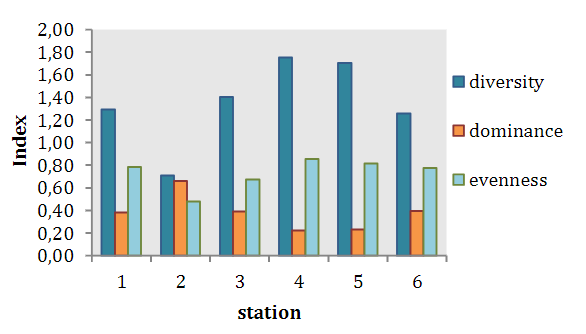Structure and Distribution of Macrobenthos Community in Code River, Yogyakarta, Indonesia
DOI:
https://doi.org/10.51264/inajl.v2i2.17Keywords:
abundance, organic compound, diversity, dominance, macrobenthosAbstract
This research aimed to explore the community structure of macrobenthos in Code River, Yogyakarta. This research was conducted during December 2019-January 2020 in Code River, Yogyakarta. Data was taken 4 times in 6 stations. Macrobenthos was taken using a Surber net with a size of 30 x 30 cm and sampling at 5 spots in each station. Data analysis consisted of density, diversity index, dominance index, and evenness index. Water quality data consisted of water temperature, flow velocity, water depth, water pH, dissolved oxygen, and organic matter. The results showed that the density of macrobenthos ranged from 54-172 ind/m2. Our results showed that Code River has moderate diversity based on the Shannon-Wiener diversity index. Sulcospira testudinaria is the most dominant species in Code River. The evenness index showed high except at station 2 which was categorized as moderate. Code River has pretty good water quality, but stations 3, 4, and 5 which are located in the city area, it has a high organic matter content.
References
Abd Allah AT, Sumaili IA, Gathmy MY, and Awaf BA. 2018. Spatial distribution of marine invertebrates as bioindicator of water quality at intertidal zone of sandy shore habitat. Life Science Journal, 15(1), 51-55.
Asriani N, Ambo-Rappe R, Lanuru M, and Williams SL. 2019. Macrozoobenthos community structure in restored seagrass, natural seagrass and seagrassless areas around Badi Island, Indonesia. Earth and Environmental science, 253(2019), 1-7.
Borisov RR, Chertoprud ES, and Kovacheva NP. 2016. Water quality assessment in reservoirs: comparative analysis of bioindication systems based on macrobenthos characteristics. Water Resources, 43(5), 818-827.
Chen J, Hu D, Zhang C, and Ding Z. 2018. Temporal and spatial changes of macrobenthos community in the regions frequently occurring black water aggregation in Lake Taihu. Scientific Reports, 8(1), 1-13.
Kiesel J, Guse B, and Bormann H. 2019. Projecting the consequences of climate change on river ecosystems in Multiple Stressors in River Ecosystems. Elsevier, 281-301.
Litaay M, Deviana M, and Priosambodo D. 2017. Biodiversity and distribution of gastropods at seagrass meadow of Balangdatu waters Tanakeke Island South Sulawesi Indonesia. International Journal of Applied Biology, 1(2), 67-75.
Marwoto RM and Isnaningsih NR. 2012. The freshwater snail genus Sulcospira Troschel, 1857 from Java, with description of a new species from Tasikmalaya, West Java, Indonesia (Mollusca: Gastropoda: Pachychilidae). Raffles Bulletin of Zoology, 60(1), 1-10.
Mustika R, Karyadi B, and Singkam AR. 2019. Keragaman dan Kelimpahan Makroinvertebrata di Sungai Sengaur Bengkulu Tengah. Prosiding Semirata BKS PTN Wilayah Barat Bidang MIPA.
Nangin SR, Langoy ML, and Katili DY. 2015. Makrozoobentos sebagai indikator biologis dalam menentukan kualitas air Sungai Suhuyon Sulawesi Utara. Jurnal MIPA, 4(2), 165-168.
Noman MA, Mamunur R, Islam MS, and Hossain MB. 2019. Spatial and seasonal distribution of intertidal macrobenthos with their biomass and functional feeding guilds in the Naf River estuary, Bangladesh. Journal of Oceanology and Limnology, 37(3): 1010-1023.
Pawar PR and Al-Tawaha ARMS. 2017. Population density of marine macrobenthos: A tool for monitoring pollution-induced disturbance along Uran coast, Navi Mumbai. Advances in Environmental Biology, 11(10), 32-52.
Peng S, Zhou R, Qin X, Shi H, and Ding D. 2013. Application of macrobenthos functional groups to estimate the ecosystem health in a semi-enclosed bay. Marine pollution bulletin, 74(1), 302-310.
Putra H, Izmiarti, and Afrizal. 2014. Komunitas Makrozoobentos di Sungai Batang Ombilin Sumatera Barat. Jurnal Biologi UNAND, 3(3), 175-182.
Sabater S, Bregoli F, Acuña V, Barceló D, Elosegi A, Ginebreda A, and Ferreira V. 2018. Effects of human-driven water stress on river ecosystems: a meta-analysis. Scientific Reports, 8(1), 1-11.
Sharma KK and Chowdhary S. 2011. Macroinvertebrate assemblages as biological indicators of pollution in a Central Himalayan River, Tawi (J&K). International Journal of Biodiversity and Conservation, 3(5), 167-174.
Sharma KK, Langer S, and Sharma R. 2011. Water quality and macrobenthic invertebrate fauna of Behlol Nullah, Jammu (J&K). The Ecoscan, 5(3&4), 111-115.
Siahaan R, Indrawan A, Soedharma D, and Prasetyo LB. 2012. Keanekaragaman Makrozoobentos sebagai Indikator Kualitas Air Sungai Cisadane, Jawa Barat–Banten (Macrozoobenthos diversity as indicator of water quality of Cisadane River). Jurnal Bios Logos, 2(1), 1-9.
Tszydel M, Markowski M, Majecki J, B?o?ska D, and Zieli?ski M. 2015. Assessment of water quality in urban streams based on larvae of Hydropsyche angustipennis (Insecta, Trichoptera). Environmental Science and Pollution Research 22(19), 14687-14701.
Ulfa M, Julyantoro PGS, and Sari AHW. 2018. Keterkaitan komunitas makrozoobentos dengan kualitas air dan substrat di ekosistem mangrove Taman Hutan Raya Ngurah Rai Bali. Journal of Marine and Aquatic Science, 4(2), 179-190.
Weerman EJ, Herman PM, and Van de Koppel J. 2011. Macrobenthos abundance and distribution on a spatially patterned intertidal flat. Marine ecology progress series, 440, 95-103.
Welch PS. 1948. Limnology 2nd Edition. Macgraw Hill Company, New York.
Wilhm J and Dorris TC. 1966. Species diversity of benthic macroinvertebrates in a stream receiving domestic and oil refinery effluents. American Midland Naturalist, 76, 427-449.
Zawiejska J, Wy?ga B, Hajdukiewicz H, Miku? P, Ogl?cki P, Radecki-Pawlik A, and Skalski T. 2016. What improvement does a river need? New insight about the application of invertebrate based index in river health assessment. Rivers, 1-3.







